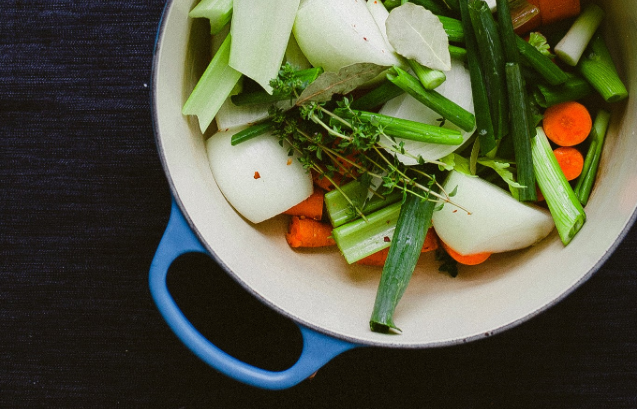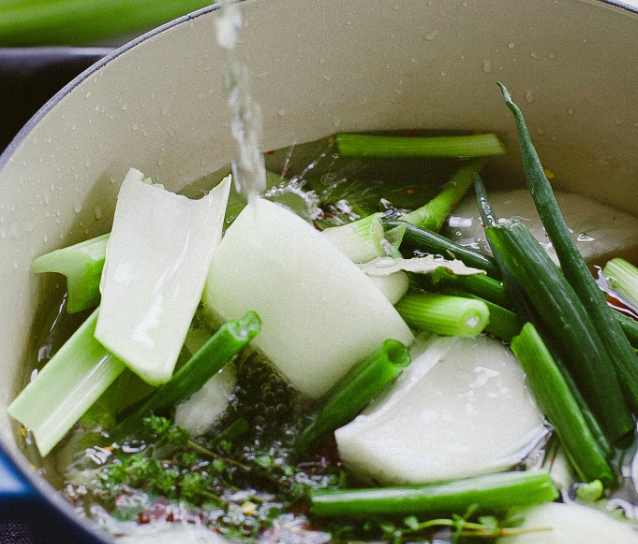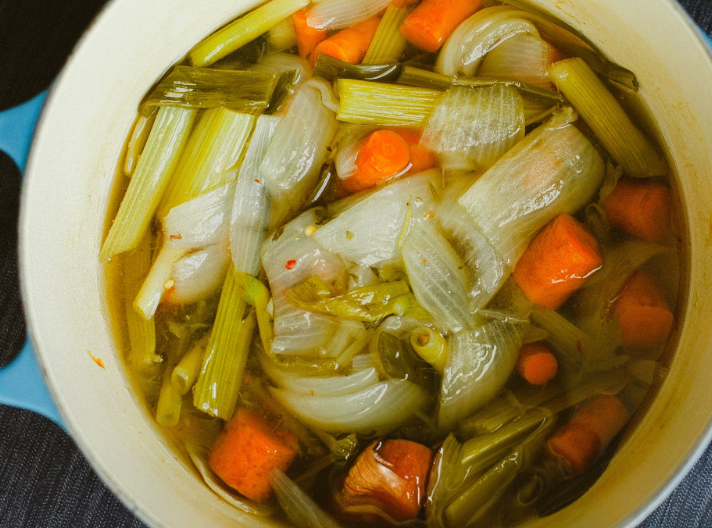
A good stock is the basis for so many classic recipes, but if your pantry and freezer are like mine, stock –whether it’s chicken, beef or vegetable– is not always around. But what I do often have is a crisper drawer full of vegetable scraps that can easily turned into a fragrant stock that can be used in any recipe to add a rich flavor.
Why homemade?
Making your own vegetable stock is much easier than finding your keys, jumping in the car, fighting that other lady in the car for a spot in the grocery store parking lot (just kidding, I would never do that!) and buying a box of flavorless stock off the shelves at the store. The homemade version is also much less expensive and you get to control what goes into the pot. If you know the recipe that you are going to be using the stock for you can tailor make the stock to work with the dish. For example if you are making a broth to be use in a Thai soup you can add lemongrass and lime leaves to the mix to really boost those flavors in the final dish.


The tools
Carrots, celery and onions are the basis for so many recipes and vegetable stock is no different. You want to start with those ingredients for your base and then from there you can add almost any other type of vegetable you might have lying around. Although, having said that I would recommend avoiding cruciferous vegetables like broccoli or Brussels sprouts.
The little nubs of carrots that you cut off when making another recipe, or that last bit of onion that didn’t get diced because its size made it perilous to cut, and the root base of the head of celery going into the garbage – all of these things can be saved, frozen then used to make a hearty stock. Simply keep a large airtight container or ziplock in the freezer and throw in any vegetable scraps. Now you finally have a use for the green part of the leeks! When you are making stock you are essentially trying to get all the flavor out of the vegetable and into the water so there’s no need to add the pretty pieces into the pot, they just need to be fresh and clean.
You’ll also need a large pot, water and a way to strain out the vegetables.

How to
Take all those scraps you’ve been hoarding in the freezer, or the little bits of vegetables that aren’t enough to use in a recipe but you can’t bare to throw them out and put them into a large pot. Again, it’s important to use carrots, celery and onion and from there I’d recommend some mushrooms to add a nice meatiness, tomatoes give a rich color and lovely acidic taste and I tend to use a lot of aromatics – parsley, thyme, bay leaves and peppercorns, for example.



Cover the vegetables and aromatics with water and bring it to a boil. Reduce the heat and simmer the stock
for at least an hour. At that point taste the stock for flavor. You can salt the stock a bit at this point which helps you distinguish the taste or leave out the salt so that you can better control the saltiness in the final dish. If the stock is too weak and flavorless continue to simmer until more reduced and rich in flavor.
Strain the stock through a fine sieve or cheesecloth.

For a deeper color and richer flavor you can make a stock out of roasted vegetables in the same way except that you roast all your ingredients before simmering. You can also caramelize the vegetables with a bit of oil in the pot before adding the water.
Storing
Once strained place your stock in storage containers and let cool completely. Vegetable stock will last for one week in the fridge or up to three months in the freezer.
Need some bread to go with your homemade soup. Check out this great class from Peter Reinhart about making artisan bread at home. Really, is there anything better than a bowl of homemade soup made from homemade stock and a little piece of homemade bread alongside the bowl? I think, no.


Share tips, start a discussion or ask one of our experts or other students a question.
No Responses to “Vegetable Stock: Add Flavor to Any Recipe”